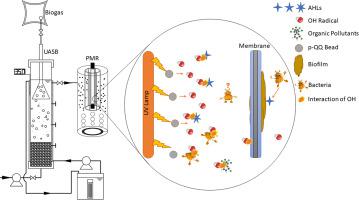Journal of Environmental Chemical Engineering ( IF 7.7 ) Pub Date : 2021-04-15 , DOI: 10.1016/j.jece.2021.105470 Ch. Tahir Mehmood , Hira Waheed , Weiyu Tan , Yeyuan Xiao

|
Microbial quorum sensing (QS) induces biofilm formation on the membrane surfaces leading to severe biofouling, which remains a major bottleneck for membrane-based systems. Here, we report an effective UV photocatalytic quorum quenching (QQ) strategy in an integrated upflow anaerobic sludge blanket – photocatalytic membrane reactor (UASB-PMR) system, where TiO2 nanoparticles immobilized in porous polymeric beads were kept in suspension as the photocatalysts. The UASB unit reached a methane yield of 0.30±0.05 L CH4/g COD removal while treating the synthetic wastewater, slightly higher than a typical internal anaerobic membrane bioreactor (AnMBR). This novel system showed 7-fold higher efficacy in membrane fouling control than the UV photolytic QQ system (19.1±2.4 d vs. 2.7±1.0 d) under intermittent UV irradiation (17% of total operation time). Continuous UV irradiation, both in photolytic and photocatalytic QQ, significantly alleviated membrane biofouling, while long-term UV exposure exerted some changes in the surface properties of the membranes, which were not observed under intermittent UV irradiation. The reactive oxygen species (ROS) generated by the UV-excited TiO2 not only oxidized the foulants on the membrane surface, but also quenched acyl-homoserine lactones (AHLs), the QS signal molecules, thus retarding membrane fouling to the maximum extent. Additionally, in-situ membrane cleaning, enhanced COD removal, and almost complete disinfection of the effluent were realized in the photocatalytic QQ system. Equipped with these advantages, this innovative photocatalytic QQ can be a readily implementable strategy to prevent fouling in external membrane bioreactors (MBRs) for the pilot- and/or full-scale applications.
中文翻译:

光催化定额猝灭:一种新的防污和原位膜清洁策略,用于与UASB耦合的外部膜生物反应器
微生物群体感应(QS)会在膜表面诱导生物膜形成,导致严重的生物积垢,这仍然是基于膜的系统的主要瓶颈。在这里,我们报告了在集成的上流厌氧污泥层-光催化膜反应器(UASB-PMR)系统中的有效的UV光催化群体猝灭(QQ)策略,在该系统中,固定在多孔聚合物珠粒中的TiO 2纳米颗粒作为光催化剂被悬浮。UASB装置的甲烷产率为0.30±0.05 L CH 4/ g处理合成废水时的COD去除量,比典型的内部厌氧膜生物反应器(AnMBR)略高。在间歇性紫外线照射(占总操作时间的17%)下,该新型系统在膜污染控制方面的功效比UV光解QQ系统(19.1±2.4 d对2.7±1.0 d)高7倍。在光解和光催化QQ中连续进行紫外线照射,可显着减轻膜生物结垢,而长期紫外线照射会使膜的表面性能发生某些变化,而在间歇性紫外线照射下则未观察到这种变化。紫外线激发的TiO 2产生的活性氧(ROS)QS信号分子不仅氧化膜表面的污垢,而且还淬灭了酰基高丝氨酸内酯(AHL),从而最大程度地抑制了膜的结垢。此外,在光催化QQ系统中实现了原位膜清洁,增强的COD去除以及废水的几乎完全消毒。具备这些优势,这种创新的光催化QQ可以轻松实施,以防止中试和/或大规模应用中外膜生物反应器(MBR)结垢。



























 京公网安备 11010802027423号
京公网安备 11010802027423号